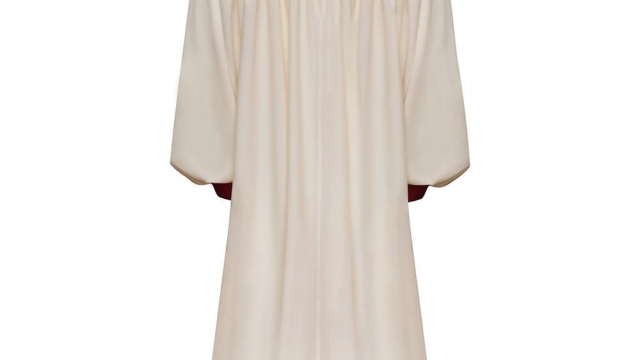
Choir robes play a significant role in the world of music, serving as both a form of attire and a symbol of unity within a vocal ensemble. These enigmatic garments not only add visual appeal to the performance, but also possess a profound sense of tradition and history. From their origins in ancient religious ceremonies to their modern-day presence in choral performances, choir robes have become an integral part of the musical enchantment that captivates audiences across the globe.
Steeped in symbolism, choir robes act as a unifying force within the ensemble, seamlessly blending voices into a harmonious whole. As each singer dons their robe, a transformation occurs, transcending individuality and emphasizing the collective power of the choir. These captivating garments create a sense of equality among the members, allowing the music to take center stage and fostering a sense of belonging within the group. Through the act of wearing choir robes, singers become part of a long-standing tradition that links them to countless performers who have donned similar attire throughout history.
Indeed, the allure of choir robes lies not only in their visual aesthetics, but also in the stories they carry. Each ensemble may have their own unique style or color scheme, with robes ranging from elegant and flowing to tailored and sleek. The choice of fabric, color, and design can reflect the character and purpose of the choir, and may even hold cultural significance. These seemingly simple garments become repositories of memories and emotions, carrying the weight of countless performances, rehearsals, and musical journeys.
Intriguing and mysterious, choir robes possess an undeniable enchantment that captures the imagination and draws us into the world of music. As we admire the performers standing before us, adorned in their robes, we become part of a centuries-old tradition that celebrates the power of the human voice. So next time you find yourself enthralled by the choral melodies filling the air, take a moment to appreciate the enigmatic allure of the choir robes that add an extra layer of magic to the musical experience.
The Symbolism of Choir Robes
Choir robes have long held a significant place within the realm of music and spirituality. These garments, worn by singers during choral performances, carry deep symbolism that goes beyond their aesthetic appeal. Through their design and colors, choir robes convey profound messages and reflect the sacredness of the musical experience.
The traditional shape of choir robes, typically long and flowing, symbolizes the unity and harmony that music brings. Just as each singer contributes their unique voice to create a beautiful melody, the robes encompass and unite the individual members into a collective, harmonious whole. This visual representation of unity serves as a reminder that music has the power to transcend individual differences and create a sense of oneness.
The colors of choir robes also play a significant role in their symbolism. Often, the color of the robes corresponds to the liturgical seasons or events. For example, white robes may be worn during joyful celebrations, representing purity and divine light. On the other hand, dark-colored robes, such as purple or black, may be worn during more solemn occasions, signifying introspection and reverence.
Furthermore, choir robes can be seen as a form of humble attire, allowing the focus to remain on the music and the spiritual message it conveys. By donning these robes, singers set aside their personal identities and become vessels through which the power of music flows. This symbolism underscores the selfless nature of choral singing, where individual egos are set aside for the greater purpose of creating a collective, transcendent musical experience.
In conclusion, choir robes hold profound symbolism that encompasses unity, spirituality, and humility. These garments not only enhance the visual presence of a choir but also serve as a reminder of the deeper meaning behind their musical performances. By understanding the symbolism of choir robes, we gain a deeper appreciation for the enchanting and transformative power of choral music.
Styles and Colors of Choir Robes
Choir robes come in a variety of styles and colors, reflecting the unique traditions and preferences of different choirs. The design of the robes often carries symbolic meanings and adds to the enchantment of the musical performances.
One popular style of choir robes is the classic choir cassock. This traditional robe reaches to the ankles and features long, flowing, and loose sleeves. The cassock is often adorned with contrasting trimmings or decorative buttons, adding an elegant touch to the overall appearance. It exudes a sense of timelessness and reverence, creating a striking visual impact during choral presentations.
In addition to the cassock style, many choirs opt for the surplice robe. This robe is characterized by its shorter length, typically ending around the knee or mid-thigh. It is distinguished by its delicate, lacy sleeves, which give the robe a graceful and ethereal look. The surplice robe is often chosen for more informal or contemporary performances, as it allows for greater ease of movement while still maintaining a sense of tradition.
When it comes to colors, choirs have a wide range of options to choose from. The most common color for choir robes is black, symbolizing elegance, formality, and timeless beauty. Black robes create a sense of unity among the members, with the harmonious music becoming the primary focus.
However, many choirs also opt for robes in a variety of vibrant hues, such as blue, red, green, or purple. These colors can represent different themes or evoke specific emotions. For instance, blue robes may convey a sense of tranquility and peace, while red robes might symbolize passion and energy. The selection of color can enhance the visual impact of the performance and create a captivating atmosphere.
In conclusion, the styles and colors of choir robes play an essential role in enhancing the enchanting experience of choral performances. From classic cassocks to ethereal surplices, and from the elegance of black to the vibrant hues of blue and red, these robes contribute to the mystical allure of the choir, captivating both the eyes and ears of the audience.
The Importance of Choir Robes in Musical Performances
Choir robes play a crucial role in enhancing the overall experience of musical performances. These enigmatic garments not only add visual appeal to the stage but also serve important practical purposes.
First and foremost, choir robes help create a sense of unity and cohesion among the singers. When dressed in uniform attire, the individuality of each performer is momentarily set aside, allowing the collective voice of the choir to take center stage. This visual harmony not only captivates the audience but also strengthens the connection between the singers themselves, enabling them to work together as a synchronized ensemble.
Beyond aesthetics, choir robes also aid in acoustics during performances. The flowing and loose-fitting nature of the robes helps to amplify and project the vocal sound. The fabric of the robes acts as a natural sound barrier, preventing any potential distractions caused by rustling clothing or other micro-noises. This allows the audience to fully immerse themselves in the ethereal melodies without any auditory disruptions.
Moreover, choir robes symbolize a tradition that has been cherished for centuries. From the earliest days of choral singing, these robes have been worn to honor the music, the composer, and the art form itself. Through wearing these robes, singers pay homage to the rich history and legacy of choral music, fostering a profound respect for the craft and its roots.
In conclusion, choir robes hold a special place in the realm of musical performances. They not only contribute to the visual allure of the stage but also facilitate the harmonious blend of voices and improve acoustics. Furthermore, these robes embody a sense of tradition and reverence, reminding us of the timeless power and enchantment of choral music.






